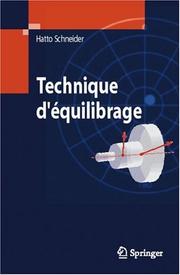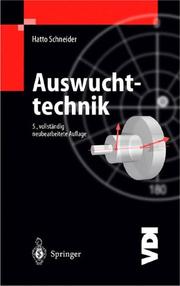| Listing 1 - 10 of 11 | << page >> |
Sort by
|

ISBN: 1280614161 9786610614165 2287327517 2287327509 Year: 2006 Publisher: Paris : Springer,
Abstract | Keywords | Export | Availability | Bookmark
 Loading...
Loading...Choose an application
- Reference Manager
- EndNote
- RefWorks (Direct export to RefWorks)
La technique d'iquilibrage fait partie de notre environnement. Elle est prisente non seulement au sein des processus industriels, mais igalement dans notre vie quotidienne. Les familles de pihces concernies par l'iquilibrage pratiquement tout ce qui tourne sont si itendues, leur comportement est si varii, les objectifs poursuivis sont si diffirents, que seules de solides connaissances de base et une approche systimatique permettent d'affronter cette tbche dans les meilleures conditions. Cet ouvrage doit apporter au lecteur les connaissances fondamentales lui permettant de risoudre dans les rhg
Rotors. --- Rotational motion. --- Gyrodynamics --- Revolving systems --- Rotating systems --- Spin (Dynamics) --- Dynamics --- Motion --- Rotational motion
Book
ISBN: 3662660490 3662660482 Year: 2023 Publisher: Berlin, Heidelberg : Springer Berlin Heidelberg : Imprint: Springer Vieweg,
Abstract | Keywords | Export | Availability | Bookmark
 Loading...
Loading...Choose an application
- Reference Manager
- EndNote
- RefWorks (Direct export to RefWorks)
Balancing of rotors is an indispensable process for the quality management, involving many steps from design to maintenance. With many developments of rotors – with new concepts, materials and machining methods – the challenges on balancing processes change. In search for an optimum solution for these complex tasks, no patent remedies will help, but only a sound knowledge of the theoretical background of rotor balancing, of its practical implementation and of the performance of the various balancing systems. This book is intended to support systematic familiarisation with the subject and ongoing training – in practice as well as in theory. A focus of current ISO Standards development is on errors that occur during balancing – intentionally created, or accidentally generated. They must be properly analysed and taken into account in order to determine the permissible readings for residual unbalances. The acceptance criteria were specified precisely so that the balancing objective – the targeted balancing quality – can be reliably achieved. Even today, balancing rotors with shaft-elastic behaviour often is carried out following certain established in-house rules. For this reason, the modal approach was further elaborated – partly on the basis of DIN ISO 21940 – Part 12, Supplement 1. The difficult choice of correction planes for the flexural modes is explained also by various examples. Target groups · Manufacturers and users of rotating machinery, in the following areas: layout, design, computation, machine procurement, work planning, manufacturing, assembly, rotor balancing, test floor, commissioning, maintenance. · Specialists for maintenance and technical acceptance. · Teacher, lecturers and students in the area of mechanical engineering. The author Dipl.-Ing. Hatto Schneider studied mechanical engineering at the Technical University Aachen, Germany. After work for three years at KFA Jülich (Germany) in the development of high-speed rotors, he joined Carl Schenk AG, Germany, for rotor balancing machines, where he headed the technical sales department for over 20 years. Today he consults in rotor balancing and gives lectures on current balancing problems. Publications on rotor balancing technology and participation in standardisation committees such as ISO, DIN, VDI and SAE prove his commitment and competence in rotor balancing.
Multibody systems. --- Vibration. --- Mechanics, Applied. --- Mechanical engineering. --- Industrial engineering. --- Production engineering. --- Multibody Systems and Mechanical Vibrations. --- Mechanical Engineering. --- Industrial and Production Engineering. --- Manufacturing engineering --- Process engineering --- Industrial engineering --- Mechanical engineering --- Management engineering --- Simplification in industry --- Engineering --- Value analysis (Cost control) --- Engineering, Mechanical --- Machinery --- Steam engineering --- Applied mechanics --- Engineering mathematics --- Cycles --- Mechanics --- Sound --- Multi-body systems --- Systems, Multibody --- Mechanics, Analytic
Digital
ISBN: 9782287327513 Year: 2006 Publisher: Paris Springer-Verlag France, Paris
Abstract | Keywords | Export | Availability | Bookmark
 Loading...
Loading...Choose an application
- Reference Manager
- EndNote
- RefWorks (Direct export to RefWorks)
Classical mechanics. Field theory --- Physics --- Engineering sciences. Technology --- Production management --- toegepaste wetenschappen --- kwaliteitscontrole --- ingenieurswetenschappen --- fysica --- dynamica
Multi
ISBN: 9783662660492 9783662660485 9783662660508 9783662660515 Year: 2023 Publisher: Berlin Springer, Imprint: Springer Vieweg
Abstract | Keywords | Export | Availability | Bookmark
 Loading...
Loading...Choose an application
- Reference Manager
- EndNote
- RefWorks (Direct export to RefWorks)
Balancing of rotors is an indispensable process for the quality management, involving many steps from design to maintenance. With many developments of rotors - with new concepts, materials and machining methods - the challenges on balancing processes change. In search for an optimum solution for these complex tasks, no patent remedies will help, but only a sound knowledge of the theoretical background of rotor balancing, of its practical implementation and of the performance of the various balancing systems. This book is intended to support systematic familiarisation with the subject and ongoing training - in practice as well as in theory. A focus of current ISO Standards development is on errors that occur during balancing - intentionally created, or accidentally generated. They must be properly analysed and taken into account in order to determine the permissible readings for residual unbalances. The acceptance criteria were specified precisely so that the balancing objective - the targeted balancing quality - can be reliably achieved. Even today, balancing rotors with shaft-elastic behaviour often is carried out following certain established in-house rules. For this reason, the modal approach was further elaborated - partly on the basis of DIN ISO 21940 - Part 12, Supplement 1. The difficult choice of correction planes for the flexural modes is explained also by various examples. Target groups · Manufacturers and users of rotating machinery, in the following areas: layout, design, computation, machine procurement, work planning, manufacturing, assembly, rotor balancing, test floor, commissioning, maintenance. · Specialists for maintenance and technical acceptance. · Teacher, lecturers and students in the area of mechanical engineering. The author Dipl.-Ing. Hatto Schneider studied mechanical engineering at the Technical University Aachen, Germany. After work for three years at KFA Jülich (Germany) in the development of high-speed rotors, he joined Carl Schenk AG, Germany, for rotor balancing machines, where he headed the technical sales department for over 20 years. Today he consults in rotor balancing and gives lectures on current balancing problems. Publications on rotor balancing technology and participation in standardisation committees such as ISO, DIN, VDI and SAE prove his commitment and competence in rotor balancing.
Methodology of economics --- Mechanical properties of solids --- Applied physical engineering --- Engineering sciences. Technology --- Production management --- Business management --- Business economics --- patroonherkenning --- financieel management --- toegepaste mechanica --- productie --- ingenieurswetenschappen --- optica
Book
ISBN: 3184030296 Year: 1972 Publisher: Duesseldorf VDI
Abstract | Keywords | Export | Availability | Bookmark
 Loading...
Loading...Choose an application
- Reference Manager
- EndNote
- RefWorks (Direct export to RefWorks)
Materials processing --- werktuigbouwkunde --- werkplaatstechniek

ISBN: 3540675647 Year: 2000 Publisher: Berlin Springer
Abstract | Keywords | Export | Availability | Bookmark
 Loading...
Loading...Choose an application
- Reference Manager
- EndNote
- RefWorks (Direct export to RefWorks)
Man begegnet auszuwuchtenden Rotoren nicht nur bei industriellen Prozessen, sondern auch im alltäglichen Umfeld. Die Fülle der Teile, die ausgewuchtet werden - nahezu alles, was sich dreht - ist so groß, ihr Verhalten so unterschiedlich, die Ziele so vielfältig, daß nur ein gutes Hintergrundwissen und ein systematischer Ansatz helfen. Dieses Buch soll den Lesern die Grundlage dazu vermitteln, um die immer wieder neu auftretenden Probleme sachgerecht und wirtschaftlich lösen zu können.
Materials processing --- werktuigbouwkunde --- werkplaatstechniek
Book
ISBN: 3642249140 Year: 2013 Publisher: Berlin : Springer Vieweg,
Abstract | Keywords | Export | Availability | Bookmark
 Loading...
Loading...Choose an application
- Reference Manager
- EndNote
- RefWorks (Direct export to RefWorks)
Auswuchten ist für das Qualitätsmanagement von Rotoren ein unverzichtbarer Prozess, der Etappen von der Konstruktion bis zur Inbetriebnahme umfasst. Mit jeder Weiterentwicklung der Rotoren – mit neuen Konzepten, Materialien und Bearbeitungsmethoden – verändern sich die Anforderungen an die Auswuchttechnik. Auf der Suche nach der jeweils optimalen Lösung dieser komplexen Aufgaben helfen keine Patentrezepte, sondern nur ein fundiertes Wissen über die theoretischen Hintergründe des Auswuchtens, seine praktische Durchführung und die Leistungsfähigkeit der verschiedenen Auswuchtsysteme. In der 8. Auflage wird die neue Sichtweise der Auswuchttheorie erläutert, wie sie als Einführung in die Auswuchttechnik in DIN ISO 19499 beschrieben und in E-VDI 3835 – anhand von wellenelastischen Rotoren – vertieft wird. Das Buch beschreibt den aktuellen Wissensstand und die Normung auf diesem Spezialgebiet. Es soll die systematische Einarbeitung in das Fachgebiet – im Studium ebenso wie in der Industrie – sowie die ständig erforderliche Weiterbildung unterstützen.
Mechanical engineering. --- Vibration. --- Dynamical systems. --- Dynamics. --- Quality control. --- Reliability. --- Industrial safety. --- Mechanical Engineering. --- Vibration, Dynamical Systems, Control. --- Quality Control, Reliability, Safety and Risk. --- Balancing of machinery.
Book
ISBN: 3540490922 Year: 2007 Publisher: Berlin, Heidelberg : Springer-Verlag Berlin Heidelberg,
Abstract | Keywords | Export | Availability | Bookmark
 Loading...
Loading...Choose an application
- Reference Manager
- EndNote
- RefWorks (Direct export to RefWorks)
Auswuchten ist für die Qualitätssicherung von Rotoren ein unverzichtbarer Schritt. Mit jeder Weiterentwicklung der Rotoren – mit neuen Konzepten, Materialien und Bearbeitungsmethoden – verändern sich die Anforderungen an die Auswuchttechnik. Die ganze Bandbreite der Aufgaben wird sichtbar, wenn man bedenkt, dass in kleinen und mittleren Betrieben ebenso viele Auswuchtmaschinen laufen wie in großen Konzernen, und dass die Stückkosten für das Auswuchten manchmal nur ein paar Cent betragen, in anderen Fällen aber auch 100.000 EUR überschreiten können. Auf der Suche nach der jeweiligen optimalen Lösung dieser komplexen Aufgabe helfen keine Patentrezepte, sondern nur ein fundiertes Wissen über die theoretischen Hintergründe des Auswuchtens, seine praktische Durchführung und die Leistungsfähigkeit der verschiedenen Auswuchtsysteme. Das Buch beschreibt den aktuellen Wissensstand und die Normung auf diesem Spezialgebiet. Es soll die systematische Einarbeitung in das Fachgebiet unterstützen – im Studium ebenso wie in der Industrie. Der Erfahrene in der Industrie wird es als Nachschlagewerk zur Lösung von Detailfragen heranziehen. Die neu bearbeitete 7. Auflage wurde durch wichtige Änderungen in den Normen, vor allem in DIN ISO 1940-1, notwendig. Die Einführung spezieller Toleranzebenen wird das Auswuchten von Rotoren im starren Zustand nachhaltig verändern und auch zu neuen Lösungen bei den Messgeräten der Auswuchtmaschinen führen.
Mechanical engineering. --- Engineering. --- Quality control. --- Reliability. --- Industrial safety. --- Vibration. --- Dynamical systems. --- Dynamics. --- Mechanical Engineering. --- Engineering, general. --- Quality Control, Reliability, Safety and Risk. --- Vibration, Dynamical Systems, Control. --- Automation. --- Artificial intelligence.
Book
ISBN: 9783642249136 Year: 2013 Publisher: Springer Vieweg
Abstract | Keywords | Export | Availability | Bookmark
 Loading...
Loading...Choose an application
- Reference Manager
- EndNote
- RefWorks (Direct export to RefWorks)
Book
ISBN: 3184032299 Year: 1977 Publisher: Düsseldorf VDI
Abstract | Keywords | Export | Availability | Bookmark
 Loading...
Loading...Choose an application
- Reference Manager
- EndNote
- RefWorks (Direct export to RefWorks)
| Listing 1 - 10 of 11 | << page >> |
Sort by
|

 Search
Search Feedback
Feedback About UniCat
About UniCat  Help
Help News
News